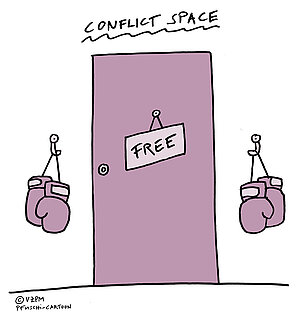Conflict and crisis
Definition
Conflict and crisis includes moderating or solving conflicts and crises by being observant of the environment and noticing and delivering a remedy for disagreements. Conflicts and crises may include events and situations, character conflicts, stress levels and other potential dangers. The individual must handle these scenarios appropriately and stimulate a learning process for future conflicts and crises.
Purpose
The purpose of this competence element is to enable the individual to take effective action when a crisis or clash of opposing interests/incompatible personalities occurs.
Description
Conflicts may occur between two or more people and/or parties. Very often, a conflict erodes a good working environment and may result in a negative effect for the parties involved. A crisis may be the outgrowth of a conflict, or it may be the result of a sudden, abrupt or decisive change in a situation that threatens to thwart the realisation of the goals of the project, either directly or indirectly. At such times, a rapid response is required and skilled judgment needs to be applied to assess the crisis, define scenarios to solve the crisis and secure the project and to decide whether to escalate the issue and how high this needs to go in the organisation.
The ability to identify potential conflicts and crises and to react accordingly needs an understanding of the fundamental mechanisms. The individual can use a variety of means for reacting to potential or actual conflict and crisis, for example collaboration, compromise, prevention, persuasion, escalation or the use of power. Each depends on achieving a balance between interests. Transparency and integrity shown by the individual, acting as an intermediary between parties in conflict, will help in finding acceptable solutions. However, sometimes conflicts cannot be solved from within the team or the project but only by calling in independent mediating or deciding parties.
Key competence indicators
Anticipate and possibly prevent conflicts and crises
To be aware of potential conflicts and crises means being alert and observant of situations that might lead to disagreements. Possible conflicts are ideally identified and prevented or tackled at an early stage before they expand. Prevention includes pre-empting conflict topics, keeping team members with conflicting characters or interests in separate teams and/or delegating conflict-sensitive items to specific people. Stress is a very likely factor in potential conflicts or crises, as people tend to get irritable under pressure. The individual should therefore be able to recognise, assess and reduce individual stress levels.
Measures
- Analyses potentially stressful situations
- Keeps conflicting characters or interests in separate tasks/teams
- Delegates conflict-sensitive items to specific people
- Implements preventive measures
- Takes stress-reducing measures
- Reflects on stressful situations in a team
Analyse the causes and consequences of conflicts and crises and select appropriate response(s)
Conflicts pass through various stages. These stages can be summarised in three broad categories:
- Latent (potential, slumbering, but not yet visible or acknowledged). This exists whenever individuals or groups have differences that bother one or the other, but the differences are not great enough to cause one side to act to alter the situation.
- Emergent (visible but still rational). This may happen when a ‘triggering event’ happens, for instance an open disagreement on a topic. This topic is either the real cause of the conflict, or a pretext for another conflict of interest or character. When the conflict is emergent, the involved parties are still on speaking terms and can discuss rational solutions.
- Escalated (open conflict). In this phase the parties are openly and emotionally at odds with each other and are not able or willing any more to discuss solutions calmly and rationally. Other people are tending to take sides, or they are or urged to do so. In some situations legal steps may be taken or considered.
Crises, by contrast, jump immediately to the third level without acknowledged intermediary steps. However, they are often not the result of conflict situations but may arise because of a sudden or suddenly discovered issue – a major risk occurring, an outside event with great impact, etc. The art of conflict and crisis management is to assess causes and consequences and obtain additional information for use in the decision-making process to define possible solutions.
Conflicts and crises can have very different causes, varying from factual disagreements to character conflicts, and they may have origins that are external to the project or even the organisation. Depending on the causes, different solutions may be possible.
Crises can also be differentiated by their potential impacts. Depending on the specific stage, different approaches to soothe, solve or escalate the conflict or crisis can be chosen.
Measures
- Assesses conflict stage
- Analyses causes of a conflict or crisis
- Analyses potential impact of a conflict or crisis
- Has different conflict or crisis approaches available to choose from
Mediate and resolve conflicts and crises and/or their impact
Often conflict or crisis management has to be performed against a background of individuals and/or groups who are angry or in panic mode. In a minimum amount of time, the individual has to pull the information together, weigh the options, aim for a positive and preferably synergistic solution and, most importantly, stay calm and in control. In these circumstances, relaxation and balanced judgment are important qualities. In situations of crisis the ability to act decisively is most important.
The potential means of resolving conflicts involve collaboration, compromise, prevention or use of power. Each depends on achieving a balance between one’s own and others’ interests. Cooperative conflict management requires a willingness to compromise among all parties. In the early stages of conflicts the individual can act as a moderator/mediator – at least when the individual is not directly involved. The individual brings the conflicting parties together and enables communication without being too judgmental. In later stages the options may include use of power, escalation to higher management, professional mediation and/or legal measures.
Measures
- Addresses issues openly
- Creates an atmosphere of constructive debate
- Selects and uses the right method to solve the conflict or crisis
- Takes disciplinary or legal measures when appropriate
Identify and share learning from conflicts and crises in order to improve future practice
Once a conflict has been resolved, it is important to restore a sense of harmony and equilibrium to the environment. Stimulating learning from conflicts and crises means the individual can question the origins and causes of a conflict on a meta-level. Furthermore the individual can differentiate between environmental coincidences and true causes of a conflict or crisis, learn from them and encourage the team to do the same, so that they cope better with similar situations in the future.
Measures
- Restores the team environment
- Motivates the team to acknowledge and learn from their own part in the conflict
- Uses conflicts in a positive way to progress
- Strengthens the team cohesion and solidity with regard to potential future conflicts and crises


